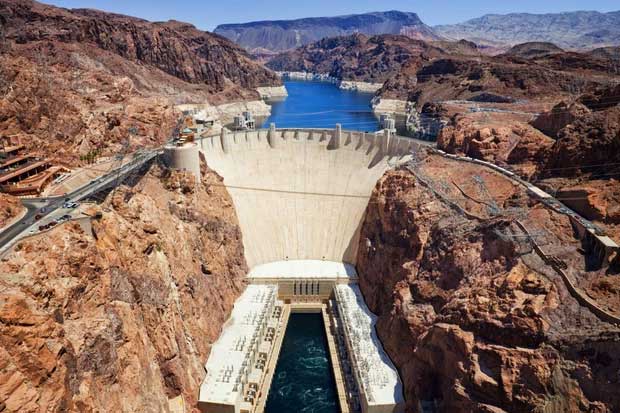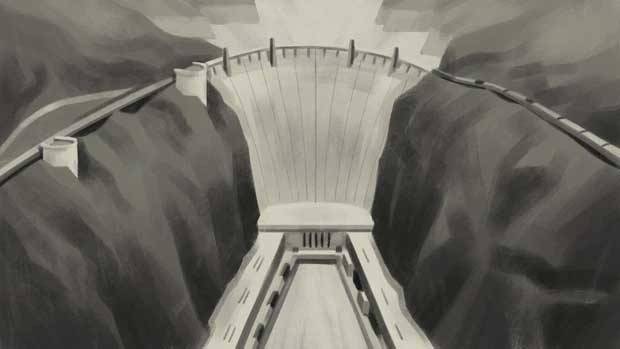The dark history of the dam in the top 7 greatest works in American history: The price to pay is very expensive
The Hoover Dam was among the most important American structures of the 20th century. But for it, they had to pay a heavy price.
Above the Black Canyon of Nevada (USA) is a group of workers hanging on the cliff, with a rope tied around their back.
Suddenly, someone walked up to the wall. The ground broke, and he fell straight down the cliff, with a speed so fast that no one had time to react. Fortunately, a worker, who was already deeper, threw himself off the cliff, caught up with the man, and brought him back to safety.
The person who was saved was an engineer. After rescuing him, the worker went back down and continued his work.
And it was a routine day in this canyon, during the construction of the Hoover Dam - one of the seven greatest constructions in America - in the early 20th century.

Hoover Dam is one of the top 7 greatest works in American history
The origin of a giant dam
In the early years of the 20th century, the United States began to expand and develop to both sides. The problem began to arise, about many large cities in the arid Southwest that still did not have a reliable source of water to use.
While the Colorado River has been diverted by numerous canals, its erratic flow frequently causes flooding, leading to unsustainable agriculture. At the same time, the cities and industrial zones of the Southwest are growing very rapidly, which means they need more and more energy.

Hoover Dam Construction Plan Begins
To solve this story, the United States Department of Corrections in 1922 came up with a solution by building a giant hydroelectric dam, with the consensus of 7 states around the Colorado River. They all agreed that the Black Canyon was the most suitable place to build an arch dam.
An arch dam is an arc-shaped dam structure built upstream, taking advantage of the water's thrust and transferring the horizontal pressure of the water to the shore - in this case, the cliff - to create stability. The arch dams were built by many ancient civilizations, but at that time the scale at Black Canyon was the largest. According to the plan, when completed, the dam is expected to be 221m high, the arch width is 379m.
Pay with blood and flesh
To create such a large-scale dam requires a huge amount of manpower. But because the Great Economic Crisis took place only 1 year after the project was approved, the number of people applying for a job here reached thousands.
The earliest arrivals camped near the structure, creating a "makeshift" village called Ragtown (or "Rag Village"). With no facilities, lack of necessities, and no protection, many of them died of heatstroke during the hot summer. The US government then had to decide to build the city of Boulder with many amenities and even a state-of-the-art hospital to secure the workforce, preparing for their important project.


The people who applied first turned out to be the unlucky ones
Before construction began, the Colorado River was forced to reflow. They blew up the sides of the canyon, installed giant pipes 5km in total, capable of transporting 5,600 cubic meters of water per second. However, to ensure the pipeline is installed on time, the workers are under a lot of pressure and work in a shabby environment. The temperature in the installation tunnels was so great that many people collapsed.
In the fall of 1932, the river was successfully diverted, but only to expose the workers to more dangerous jobs ahead. Their goal now is to break and clear about. 1 million cubic meters of rock on the cliff.
The foremen gathered people familiar with the work of heights, ordering ropes to descend on cliffs, chipping rocks with awls and dynamite. From circus actors to sailors, even Aboriginal people, they volunteered (for money) to defy death, doing this dangerous work.

The workers were asked to tie ropes down the cliff, chiseling rocks with awls and dynamite.
After clearing the stone wall, the dam was officially started construction. They needed to pour about 6.6 million tons of concrete into it - enough to pave a road across the United States. But that huge amount of concrete, if poured at once, will take a long time for it to cool and harden - more than 125 years. So to speed up the time, they poured concrete into the subdivisions, each of which was fitted with a water pipe running through it.

Concrete is poured into subdivisions, with cold water pipes running through them to cool them faster
In 1935, almost the entire dam was completed, two years earlier than planned. On February 1, 1935, diversion tunnels were opened to allow water to overflow into the dam's reservoir, with a capacity to store water more than twice the annual flow of the Colorado River. At that time, the dam was the tallest man-made structure in the world, a proud milestone in the nation's history.

More than 100 people died during the construction of the Hoover Dam.
But that comes with such a fast build speed comes the price to pay. The construction employed 21,000 people as a result of the Great Depression, and more than 100 people died during construction. Besides, the construction of reservoirs that store too much water has destroyed many communities, and devastated the ecosystem around the Colorado River.
Today, the Hoover Dam generates 4 billion kWh per year, providing enough electricity for 1.3 million residents. However, the consequences of the dam's construction are still a ripple that is difficult to erase, for those who learn about the history around it.
- How is the price of iPhone X in countries selling the world's most expensive iPhone?
- F-35 fighter - The most expensive weapon program in American history
- The 10 greatest innovations in the history of world materials
- Top 7 most expensive fabrics in the world, some made from diamond chips
- The universe will expand forever
- 7 wars cost the most money in history
- The world's most expensive rare blue python is worth the price of a house
- Close up of the most expensive pillow in the world, worth the price of an apartment
- The world's most powerful digital camera hunts for dark energy
- The 10 greatest mathematicians in history
- The dark energy secret
- 5 greatest scientific achievements in NASA history
 Biography of hero Vu A Dinh
Biography of hero Vu A Dinh History of hematology
History of hematology Who is Mr. Tam Da 'Phuc-Loc-Tho' and what does it mean?
Who is Mr. Tam Da 'Phuc-Loc-Tho' and what does it mean? Unbelievable facts about the history of the oil and gas industry: Gasoline used to be cheaper than water, so abundant that it had to be dumped into the river...
Unbelievable facts about the history of the oil and gas industry: Gasoline used to be cheaper than water, so abundant that it had to be dumped into the river... What's inside the world's largest Three Gorges Dam?
What's inside the world's largest Three Gorges Dam?  St. Francis Dam Disaster in the US: Tragedy of Arrogance!
St. Francis Dam Disaster in the US: Tragedy of Arrogance!  China builds mega-dam system in the harshest place on the planet
China builds mega-dam system in the harshest place on the planet  The 300-year-old relic suddenly 'appeared' in the middle of the dam
The 300-year-old relic suddenly 'appeared' in the middle of the dam  How do humans change the world's rivers?
How do humans change the world's rivers?  3D printed 180 m high hydroelectric dam on the Tibetan plateau
3D printed 180 m high hydroelectric dam on the Tibetan plateau 